Saturday, April 17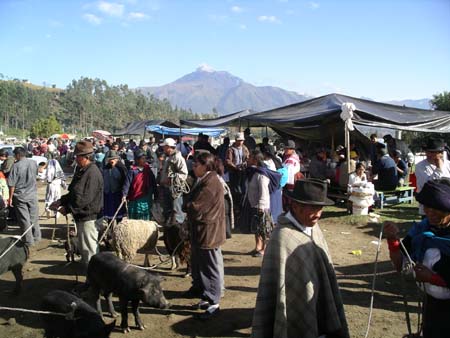
Paula: Today we rose early for Otavalo's Saturday market.
This market is renowned for its color and size and has helped make this once
small village a thriving town. When 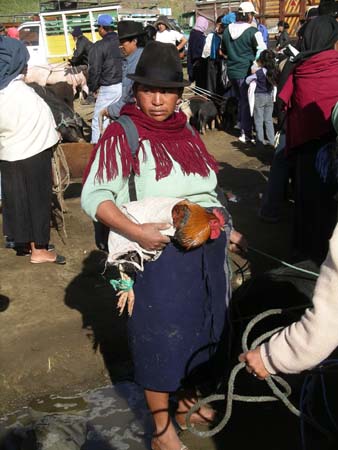 we
first scheduled our trip to Ecuador, we actually planned our itinerary specifically
so that we could be in Otavalo to see this Saturday market! Everyone we spoke
with told us that this was a not-to-be-missed experience. We were not disappointed.
we
first scheduled our trip to Ecuador, we actually planned our itinerary specifically
so that we could be in Otavalo to see this Saturday market! Everyone we spoke
with told us that this was a not-to-be-missed experience. We were not disappointed.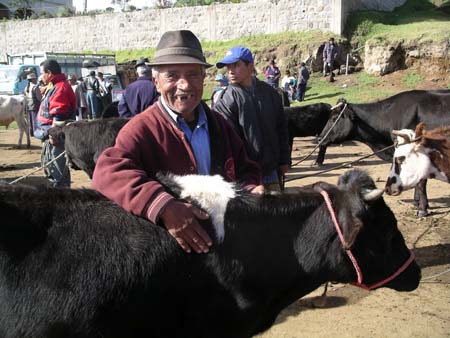
We arrived in Otavalo by 8:00 AM so that we could first experience the live
animal market. The market was sprawled over a large field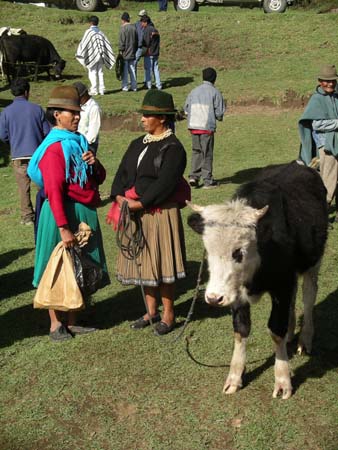 with the beautiful Andean Mountains and the imposing Cotacachi Volcano looming
in the background. What an amazing sight! It was packed with people from villages
all over the Imbabura Providence, each in their local dress. We had no difficult
getting pictures today because the market was so crowded that were a little
less conspicuous.
with the beautiful Andean Mountains and the imposing Cotacachi Volcano looming
in the background. What an amazing sight! It was packed with people from villages
all over the Imbabura Providence, each in their local dress. We had no difficult
getting pictures today because the market was so crowded that were a little
less conspicuous. 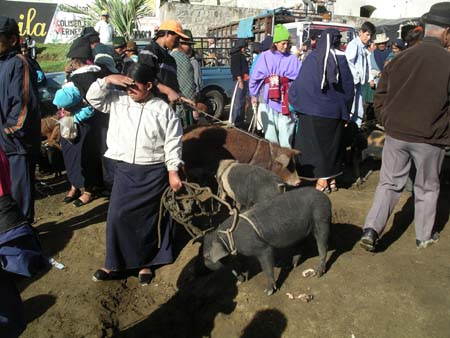
Everywhere we looked there were pigs, sheep, goats, cows and even horses
for sale. Each of the sellers claimed a small spot in the field where they
stood holding their roped animals. Interested 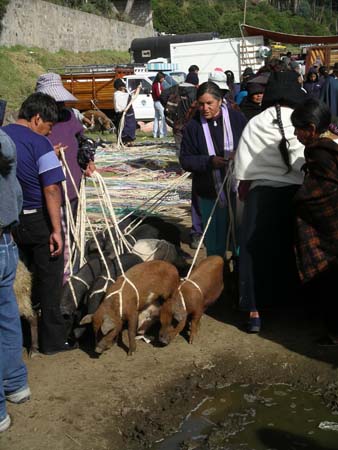 buyers
weaved through the maze examining the animals and asking for prices. Animals
were inspected, many screaming as their various orifices were painfully examined
(Steve's words, not Paula's!). It was fun to listen to the negotiations especially
since David and Katie could explain to us what was going on. We
buyers
weaved through the maze examining the animals and asking for prices. Animals
were inspected, many screaming as their various orifices were painfully examined
(Steve's words, not Paula's!). It was fun to listen to the negotiations especially
since David and Katie could explain to us what was going on. We  quickly
discovered that the going price for pigs was $20-60 depending on size, and
that cows ran from $70-150. Once purchased, the pigs were literally dragged
through the field squealing to waiting trucks. Henry
quickly
discovered that the going price for pigs was $20-60 depending on size, and
that cows ran from $70-150. Once purchased, the pigs were literally dragged
through the field squealing to waiting trucks. Henry 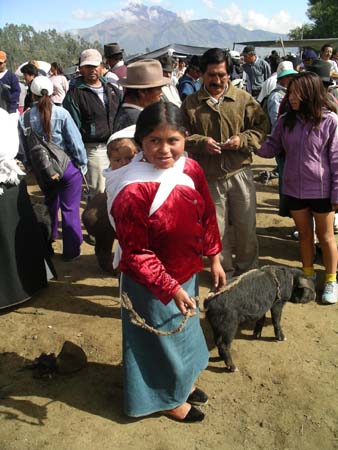 told
us that most of the animals purchased were being sold for meat and were most
likely headed straight to the butcher. Even the small pigs were being sold
for meat, since many Ecuadorian dishes use young pork.
told
us that most of the animals purchased were being sold for meat and were most
likely headed straight to the butcher. Even the small pigs were being sold
for meat, since many Ecuadorian dishes use young pork.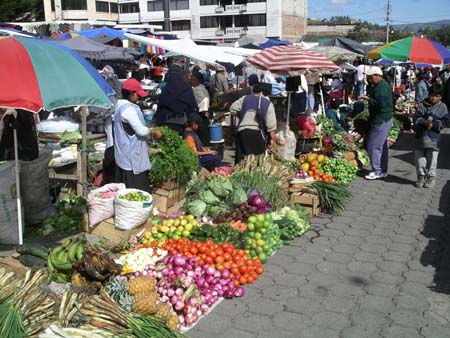
After over an hour observing the animal market, we headed toward the town
center and the main part of the market. The local food market was wonderful,
with rows of older women in traditional dress sitting on the ground .jpg) selling
corn, grains, vegetables and fruit. We saw families eating meals and shopping.
Several roasted pigs stood out - not surprising since pork is an especially
important part of the diet here.
selling
corn, grains, vegetables and fruit. We saw families eating meals and shopping.
Several roasted pigs stood out - not surprising since pork is an especially
important part of the diet here. 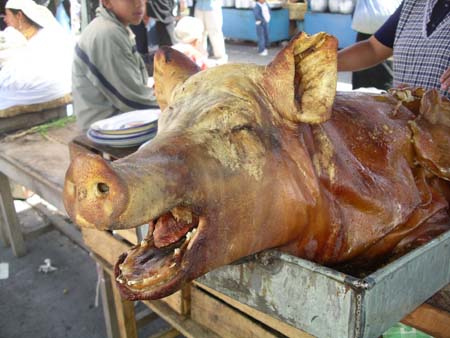
Finally, we ventured into the center of the market to explore Otavalo's famous
wool products, wood carvings and jewelry. Unlike some of the other markets
we have attended where all the shops seem to carry the same products, we found
here each family selling unique items that they had hand made. We loved the
colorful sweaters, ponchos and hats. Some of the items were made of sheep's
wool, others of wool from th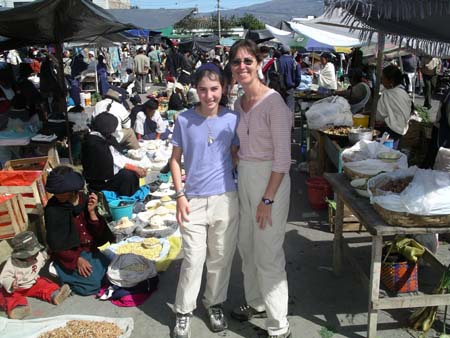 e
llama or alpaca (animal similar to the llama). The alpaca and baby llama wool
is
e
llama or alpaca (animal similar to the llama). The alpaca and baby llama wool
is 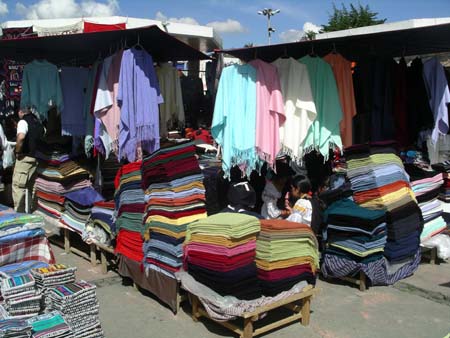 the
softest and most expensive.
the
softest and most expensive.
Each of these families was friendly and never aggressive which made our experience
here loads of fun. David and Katie had a great time negotiating and having
simple conversations using their Spanish. We found one family especially engaging
and before we knew it, we had 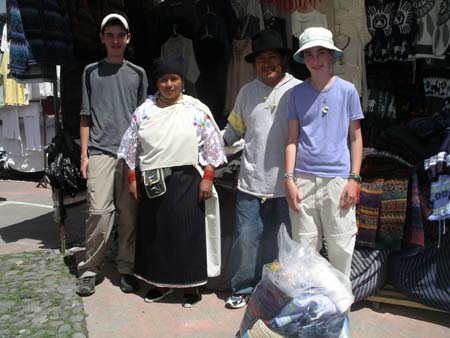 selected
a large stack of wool sweaters, ponchos and scarves. Knowing that "mucho
barato" (many items) would qualify for "mucho discount," we
eagerly awaited the family's offer only to laugh when they only
selected
a large stack of wool sweaters, ponchos and scarves. Knowing that "mucho
barato" (many items) would qualify for "mucho discount," we
eagerly awaited the family's offer only to laugh when they only 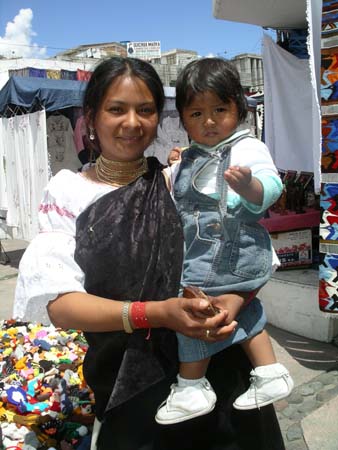 offered
us a discount of $10 of the quoted price of $230. This family soon discovered
we were not quite so naïve, and by the time we left, we had successful
negotiated the price for our large bag of woolen products down to $140. As
we waved goodbye, this family was all smiles - so we felt good knowing that
everyone felt that the exchange was a success. We
offered
us a discount of $10 of the quoted price of $230. This family soon discovered
we were not quite so naïve, and by the time we left, we had successful
negotiated the price for our large bag of woolen products down to $140. As
we waved goodbye, this family was all smiles - so we felt good knowing that
everyone felt that the exchange was a success. We 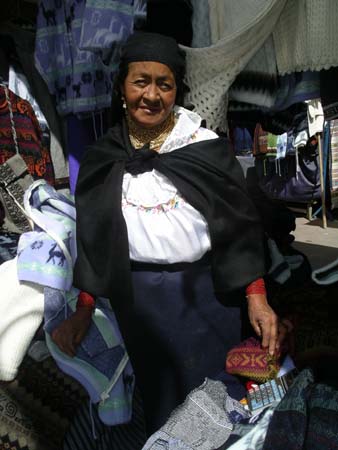 also
quickly learned that included in every negotiation should be the right to
take a photograph of the people! That resulted in some particularly nice shots
(like this one of mother and child).
also
quickly learned that included in every negotiation should be the right to
take a photograph of the people! That resulted in some particularly nice shots
(like this one of mother and child).
After over four hours in the market, we had worked up quite an appetite so
Henry and Ronaldo (our very friendly driver) took us for a special meal in
a favorite local restaurant. It is always neat to eat with local families
and taste 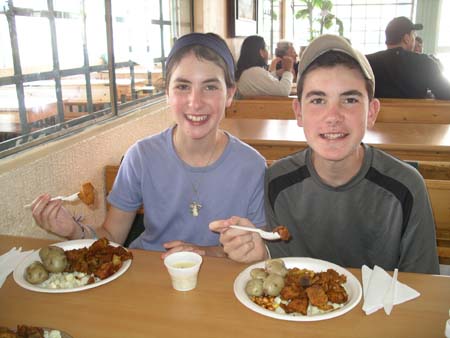 local
food. Today we tried fritadas, a tasty fried pork dish and roasted corn (mote).
The pork was delicious and the corn tasted like popcorn that was not quite
popped. After this tasty meal, we made a quick trip back to our hacienda to
pick up our luggage before driving back to Quito.
local
food. Today we tried fritadas, a tasty fried pork dish and roasted corn (mote).
The pork was delicious and the corn tasted like popcorn that was not quite
popped. After this tasty meal, we made a quick trip back to our hacienda to
pick up our luggage before driving back to Quito.
We will spend the night here before driving tomorrow to an area called "Avenue of the Volcanoes", a cloud forest where we'll spend two days rafting, horseback riding, hiking and bird watching.
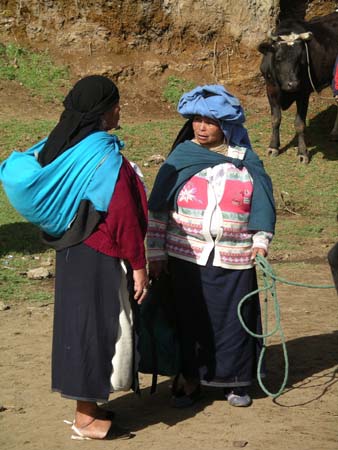
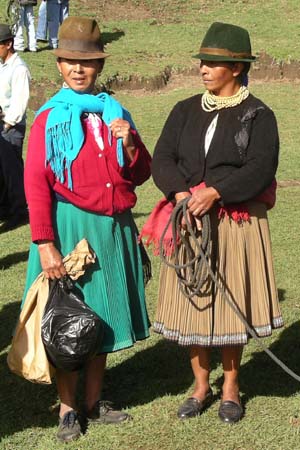
David's Daily Dump: The Otavalo Market. What an amazing experience
we had today in the incredible Otavalo Market, one of the most famous in all
of South America. It's hard to sum up what we saw in a couple of sentences,
so if you can't stay focused for more than an hour don't read another word
(kidding). To put it simply we saw farm animals, sweaters, tapestries, gloves,
hats, wood carvings, jewelry, whole roasted pigs, vegetables, ponchos, and
dolls…yeah, that's a simple list!!!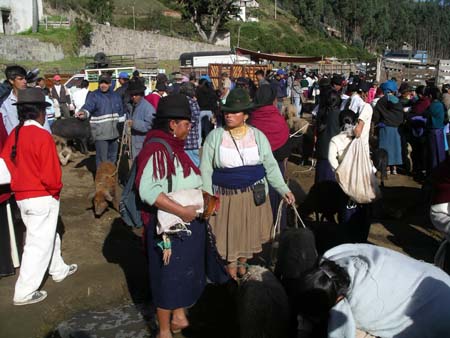
The first thing that we decided to do was to visit the animal market which turned out to be the best thing we did all day. We woke up extra early this morning to see the farmers from towns far and wide come to buy and sell farm animals. We pulled up next to the market not knowing exactly what to expect, and found ourselves starring at an everlasting sea of people with their pigs, goats, sheep, and cows. We were all stunned and expressionless at first, but soon enough grins started to appear on our faces.
As we clambered out of the van we were told by our guide to "watch our step" (the ground was covered in it!). After getting our advice we walked to the entrance and took in the amazing scene that lay before us. The first section of the market was mainly pigs with scattered sheep and goats. There must have more than 150 pigs squealing, rolling in the mud, sleeping, and fighting, just waiting to be sold! It was hard to walk through all the pigs without bumping into one or getting run over by a huge sow. You can imagine how hard it was to be looking at the animals while "watching our step." There were also mud puddles everywhere where the pigs were rolling around enjoying themselves in their last hours of life.
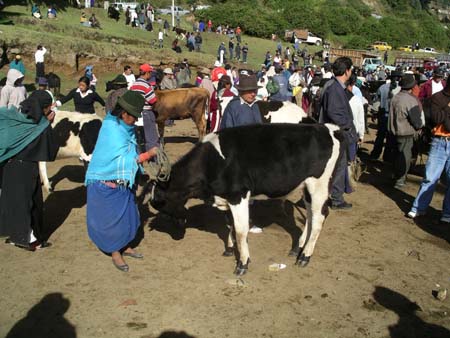 The
selling of the pigs was one of the best things we saw. Women and men alike
would inspect the pigs one by one searching for the best buy. When someone
found a pig that they liked, they would ask the price and bargain with the
owner. When a deal was made, the pigs would be led to their new owner's truck,
but never without a fight. The frightened animals would often refuse to move
their legs and have to be dragged to the car. They would squeal all the way
as if they already knew their gruesome fate. Some of them made such piercingly
loud noises that you couldn't hear a thing for five minutes!
The
selling of the pigs was one of the best things we saw. Women and men alike
would inspect the pigs one by one searching for the best buy. When someone
found a pig that they liked, they would ask the price and bargain with the
owner. When a deal was made, the pigs would be led to their new owner's truck,
but never without a fight. The frightened animals would often refuse to move
their legs and have to be dragged to the car. They would squeal all the way
as if they already knew their gruesome fate. Some of them made such piercingly
loud noises that you couldn't hear a thing for five minutes!
The larger pigs were another story. They would have to be whipped to get to
the car since no one could possibly pull them. It took many men to lift them
into the trucks (believe me, it wasn't pretty). Some of the larger pigs would
also bite their owner and chomp right down on their knees (ouch)! It was tough
to see all the pigs being led off to the butcher despite their size. It was
especially hard to see the piglets go. None of the pigs at the market would
be raised any longer…they were all headed for the dinner table. 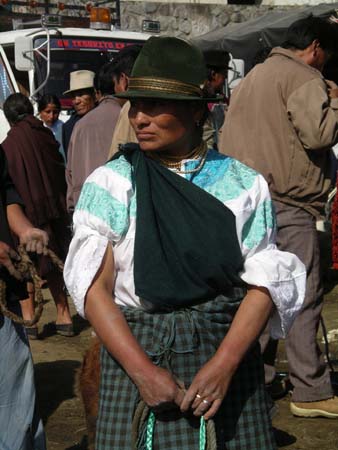
Next we made our way to the famous main Otavalo Market. One of the neat things
about this market is how different everyone is. People from all over the Imbabura
Province come to this market to sell their handicrafts. We all enjoy admiring
the women's clothing which is always extremely colorful and beautiful. .jpg) Our
guide can pick out which people are from which towns just by the way they
dress. People from Otavalo are distinguished by their black skirts, puffy
blouses, and gold necklaces.
Our
guide can pick out which people are from which towns just by the way they
dress. People from Otavalo are distinguished by their black skirts, puffy
blouses, and gold necklaces.
First, we walked through the vegetable section were the old women in traditional clothing were selling grapes, corn, cabbage, and other good looking foods. While Dad hunted out these women and snuck pictures of them, we walked into the restaurant area where huge pigs were sitting in frying pans while customers ripped off the meat.
We were immediately struck by the Spanish feel of this bustling market and the variety of products, even before we walked into the main square. One of the somewhat disturbing things that I noticed was where the women kept their money. I kept seeing the girls pulling out handfuls of coins from their shirts and handing it to the customers like it was nothing. I try not to think about where the coins in my pocket have been! We love how diverse all of the markets we visit are and how each place holds new surprises.
The next part of our adventure took place in the center of the market which is famous for its weavings. As we walked into the most well-known part of the market we were amazed at all the beautiful colors. The hats, gloves, tapestries, overcoats, sweaters, slippers, and scarves were all extremely beautiful. We were tempted to buy some and quickly found some interesting shops, and store-keepers as well...
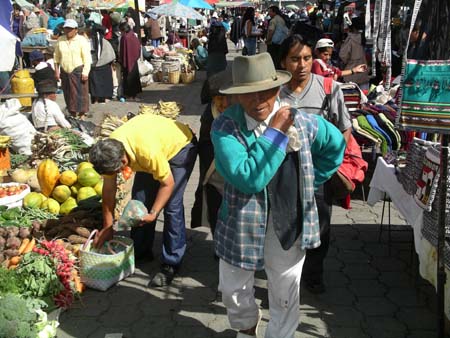 After
purchasing a couple of sweaters for Mom and Katie, we discovered a shop with
quite a variety of weavings and a pair of friendly shop-keepers. We had a
great time getting sweaters and ponchos at this shop, as well as bargaining
(what fun is buying stuff without bargaining?) and using our limited Spanish.
Coming into the weaving section, we knew that three types of material were
used: sheep wool (least expensive), llama wool (semi-expensive), and alpaca
wool (famous for its softness and pretty expensive). Everything we seemed
to point at in this shop was supposedly alpaca and baby alpaca wool. Whether
this was just coincidence or a lie we're not sure (it's hard for me to believe
that everything was alpaca).
After
purchasing a couple of sweaters for Mom and Katie, we discovered a shop with
quite a variety of weavings and a pair of friendly shop-keepers. We had a
great time getting sweaters and ponchos at this shop, as well as bargaining
(what fun is buying stuff without bargaining?) and using our limited Spanish.
Coming into the weaving section, we knew that three types of material were
used: sheep wool (least expensive), llama wool (semi-expensive), and alpaca
wool (famous for its softness and pretty expensive). Everything we seemed
to point at in this shop was supposedly alpaca and baby alpaca wool. Whether
this was just coincidence or a lie we're not sure (it's hard for me to believe
that everything was alpaca).
We all got a kick out of this knowing that the owners thought we were gullible
and weren't hard bargainers (they would soon learn the truth…) Katie
and I helped to explain what we were looking for by asking for the same design
with different colors, smaller sizes, larger sizes and so on. The owners loved
that we were speaking Spanish with them and enjoyed asking us how old we were,
what our names were, and where we learned our Spanish. After we had picked
out all of our sweaters (a forty-five minute process) the fun began. 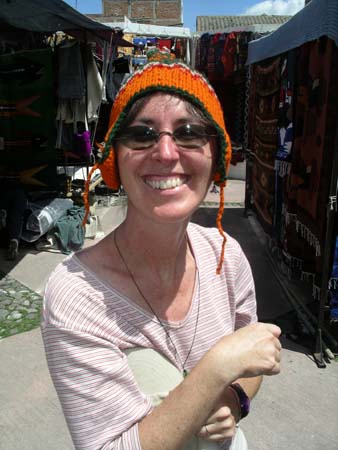
Our "amigo" (friend in Spanish…the owner) added everything up and got about 300 dollars. We immediately knew he was wrong; we got 250. We told him to add it up again and what do you know, it was 250! We were all suspicious but let it go. Now our friend said that if we bought everything (which we did) he would give us "mucho barato" (a big discount). We were expecting maybe fifty dollars to start but instead he brought it down ten bucks! We all laughed in hysterics along with the owner, although the owner's laugh was more of a "shoot, I can't trick them" kind of laugh. After about ten minutes of arguing and discussing prices, we finally agreed on 140 dollars (100 dollars less!!). The deal also included a picture with us holding our big bag of weavings! We were all laughing as we walked out with the owner's wife still showcasing sweaters for us even though we had just bought a huge bag full! After meandering through the streets a little more, we headed back to the van and enjoyed a wonderful lunch of pork (which was hard to eat after the animal market)!
One of my favorite things to do when we get to a new place is to visit the local market. In fact, that's one of the things that I like most about traveling. Not only is it interesting, it's a way to learn about the people and the culture of the local area while having fun at the same time. This was by far one of the best markets we have visited on this trip.
